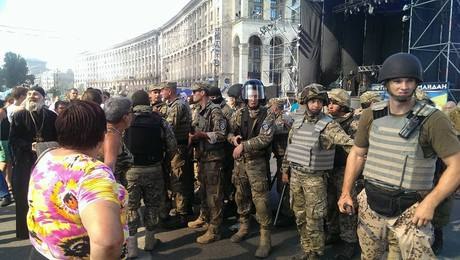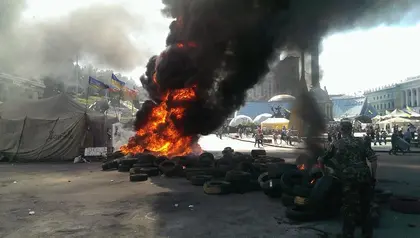The square still has a tent city left over from the revolution. However, the protesters’ space has gradually diminished as city officials have attempted to return the area to normalcy since the May 25 election of Petro Poroshenko as president and Vitali Klitschko as mayor. Many are who remain there are suspected of occupying the area after the popular uprising ended in late February.
A part of Khreshchatyk Street was cleared off last month.
JOIN US ON TELEGRAM
Follow our coverage of the war on the @Kyivpost_official.
Klitschko is taking a harder line regarding the protesters and called on the city’s police chief to defend the residents and communal worker. “The things that are going on there last time are criminal. Attacks, shootouts, explosions and taking over of businesses,” he was quoted as saying, according to his Ukrainian Democratic Alliance for Reform website. “This is a total desecration of the Maidan to which the Ukrainian came in autumn.”
Klitscho added that city authorities had long negotiations with people living in tents on Maidan in an attempt to persuade them to leave. “But these people were speaking with the stance – bring us refrigerators, WCs or something else. Is this a fight for democracy?” Klitschko said. “When there is a war on the east, where there is a need to restore the country and work some people privatized Kyiv’s center and is dictation their conditions. Moreover the major demands with which Maidan stood have been fulfilled.”
Kyiv police reported that when clearing the street, officers confiscated “guns, grenades, knives and Molotov cocktails” from the protesters, who sang patriotic songs as some threw Molotov cocktails. “Fighters of the special unit and the police officers received various wounds during the clashes mostly being hit by parts of pavement.”
A Kyiv Post reporter also saw young men carrying grenades, knives, Molotov cocktails, and one armed with an automatic rifle standing on the second-floor window sill of the central post office.
Some 300 municipal workers arrived on Maidan around 9:30 a.m. on Aug. 7, backed by cranes, to clean up the rest of the street. The workers started on both sides of Khreshchatyk – European Square closer to the Dnipro River as well as the other side.
The Kyiv Post saw volunteer Kyiv-1 and Kyiv-2 military battalions, whom the protesters called “Klitschko’s people,” accompanying the city workers. They are subordinated to the Interior Ministry and are comprised mostly from former EuroMaidan self-defense units. Kyiv-2 battalion later retreated to Prorizna Street and is currently awaiting orders. They do not give official comments, but unofficially they say their job is to peacefully clear Khreshchatyk Street for traffic.
After the attempt to clear the place began on Aug. 7, protesters started throwing cobblestones at the volunteer battalions and municipal workers and setting tires on fire, using the same defense tactics that were used during the revolution. Maidan Nezalezhnosti metro station was forced to close for exit because of fires and fights, a company spokesman said. Several tents that once stood near the intersection of Prorizna and Khreshchatyk Streets were set on fire as well.
Volodymyr, a masked 27-year-old protester from Volyn in western Ukraine who did not give his last name, said he set one of the tents on fire to prevent the communal workers from “accessing our documents and personal belongings. was ready to go to the east (of Ukraine) in several days, and I don’t know if I will now do it when such things are happening,” he said.
Ivan Lyukiv, a Maidan self-defense member said: “We will wait for Klitschko and (President Petro) Poroshenko to negotiate. They are the only two people we will negotiate with. We won’t have any discussions with the police or Kyiv-2 battalions who started the cleanup today.”
After coming across fierce resistance by the protesters, communal workers called the police. At least one protester was arrested, visible through the live feed set up by one of the activists.
A man who only identified himself as Volodymyr, one of the communal workers, said that his job was to clean up the city. “I don’t know what there people stand for. The Maidan that started in autumn achieved its goals. Kyiv is a European city and now it’s all in a mess. But the bunch of homeless people who are left here do not understand that,” he said.
The ongoing presence of protesters on Maidan is a source of deepening controversy. Many Kyivans want them gone, saying that the people who remain are not the same ones who fought the revolution.
“Activists resided in our House of Trade Unions for some time, and we all supported them up to Feb. 20. They were fed. Every day I came, checked the posts, helped them as I could. And I agree that the Maidan had to stay up to May 25, because we didn’t have a president. But there is nothing to do at the center of Ukraine after the election. There are no real activists at Maidan nowadays – they are in the east – only homeless people and titushky are here,” said Valery Kiparenko, assistant to the chairman of the Federation of Trade Unions Safety.
The tent city has, in fact, become inhabited by homeless people and other men who continue to wear masks even without much justification for hiding their identities. Crimes, including thefts and assaults, are becoming more common, residents say. Many Kyivans say the able-bodied men should battle the Russian-backed insurgents on Ukraine’s war front in the east.
The protesters who remain, however, say they stay to defend the space. Their presence, they say, is needed to hold the current government accountable and in case another revolution is needed.
Kyiv residents started gathering at the site of protests and said they support the government’s actions to clear up the capital.
“Maidan is a mess now. Russian TV will be happy to show the picture when protesters clash with utility workers here. It’s time to clean it up and solve major problems,” said Kateryna Belkova, a native Kyivan who came to Maidan on Aug. 7 to see what’s going on.
But dozens of protesters who put up resistance to the authorities clearly don’t share that point of view. Olena Leonova, one of the protesters who remains on Maidan, says that the activists here were trying to persuade the government “to make ATO (anti-terrorist operation) headquarters here on Maidan.”
“But now I see that the new government does not want to listen to people. Almost everything is the same as Yanukovych did. Maidan activists just started a dialogue with Kyiv city officials and the president’s administration, but now I see that they just want a cleanup,” Leonova said.
Klitschko said last month that the main street needs to be cleared up from protesters. “On
weekdays, Khreshchatyk is an important artery of the city and its
blockage ends up being a great inconvenience for the whole central
part of the city,” Klitschko told Radio Free Europe/Radio Liberty.
Moreover,
he had said that in its current state, Maidan no longer represents
the mood of the people. “Today it’s dangerous to be on Maidan.
There are occasional shots fired there, and fights break out. We
communicate, try to persuade people to do everything to make sure
Maidan returns to a normal life.”
Many Kyivans who came to the central square made it clear that they do not support the resistance to authorities. “Those who want to fight – go to Donbass,” shouted Yuriy Lyashko, a 51-year-old city guide who came to see what’s happening.
One communal worker said the protesters were bringing in new tires to continue resistance. Kyiv-1 and Kyiv-2 military battalions retreated with the words “glory to Ukraine.”
You can watch the live feed on Spilno.tv and on Hromadske.tv



You can also highlight the text and press Ctrl + Enter







